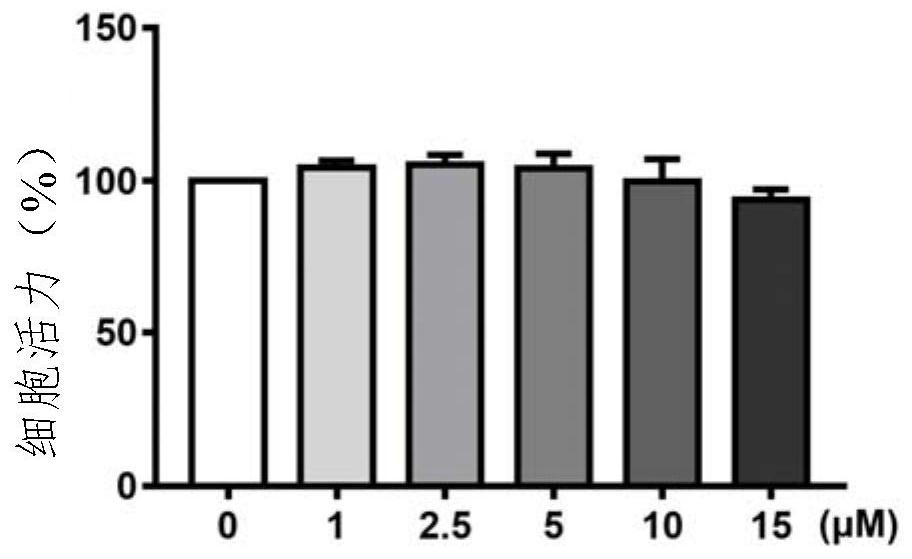Marine fungus-derived meroterpenoid compound and application in preparation of anti-hepatic fibrosis drugs
A technology of marine fungi and compounds, applied in the field of pharmaceutical compounds, can solve problems such as adverse reactions, lack of better drugs for treating liver fibrosis, etc., and achieve a promising effect.
- Summary
- Abstract
- Description
- Claims
- Application Information
AI Technical Summary
Problems solved by technology
Method used
Image
Examples
Embodiment 1
[0047] The acquisition of embodiment 1 marine fungus Aspergillus terreus GZU-31-1
[0048] The inventor's team isolated and purified a marine fungus Aspergillus terreus GZU-31-1 from the trunk of the sulphurous sulphate on the back of the sea in Xuwen, Zhanjiang City, Guangdong Province. The fungus was identified by DNA amplification and sequencing of the ITS region of the fungus. For specific steps, refer to the literature (Nature protocols, 2010, 5, 480-490; Journal of Natural Products, 2006, 69, 11, 1622-1625): using DNeasy Plant Mini The Kit kit, according to the steps in the manual, extracts DNA, uses ITS as primers for PCR amplification, and the amplified products are sequenced. The sequence obtained by sequencing was searched through the BLAST database for similarity. After comparison, the similarity between the sequence and the Aspergillus terreus fungus sequence was 100%, and the fungus was determined to be the marine fungus Aspergillus terreus GZU-31-1. The strain w...
Embodiment 2
[0049] The separation of embodiment 2 compound
[0050] A novel heteroterpene derivative was isolated from the fermentation broth of the marine fungus Aspergillus terreus GZU-31-1. The specific method is as follows:
[0051] (1) Seed liquid culture of the fungus Aspergillus terreus GZU-31-1: pick the strain and inoculate it on a slant, cultivate it at 30°C for 6 days, then insert it into a potato dextrose water medium, and cultivate it at 30°C for 3 days to obtain a seed liquid. The composition of the slant medium is calculated by weight ratio: 0.3% of glucose, 0.1% of yeast extract, 0.5% of peptone, 2.5% of agar, 3% of sodium chloride, and 98% of water. The composition of the potato glucose water culture medium is calculated by weight: 20% of potatoes, 0.3% of glucose, 3% of sodium chloride, and 100% of water.
[0052] (2) Fermentation culture of the fungus Aspergillus terreus GZU-31-1: transfer the bacterial strain in the seed solution into the fermentation medium, and let ...
Embodiment 3
[0055] The structural analysis of embodiment 3 compound
[0056] Structural analysis of the new compound 1 was carried out, and the following experimental data were obtained:
[0057] New Compound 1: C 26 h 30 o 9 , HRESI-MS: 485.1805 [M-H] - (cald for C 26 h 29 o 9 485.1806).
[0058] See Table 1 for NMR data.
[0059] The structural formula of compound 1 is as follows:
[0060]
[0061] The NMR data (CDCl 3 , 400MHz / 101MHz,ppm)
[0062]
[0063]
PUM
 Login to View More
Login to View More Abstract
Description
Claims
Application Information
 Login to View More
Login to View More - R&D Engineer
- R&D Manager
- IP Professional
- Industry Leading Data Capabilities
- Powerful AI technology
- Patent DNA Extraction
Browse by: Latest US Patents, China's latest patents, Technical Efficacy Thesaurus, Application Domain, Technology Topic, Popular Technical Reports.
© 2024 PatSnap. All rights reserved.Legal|Privacy policy|Modern Slavery Act Transparency Statement|Sitemap|About US| Contact US: help@patsnap.com










